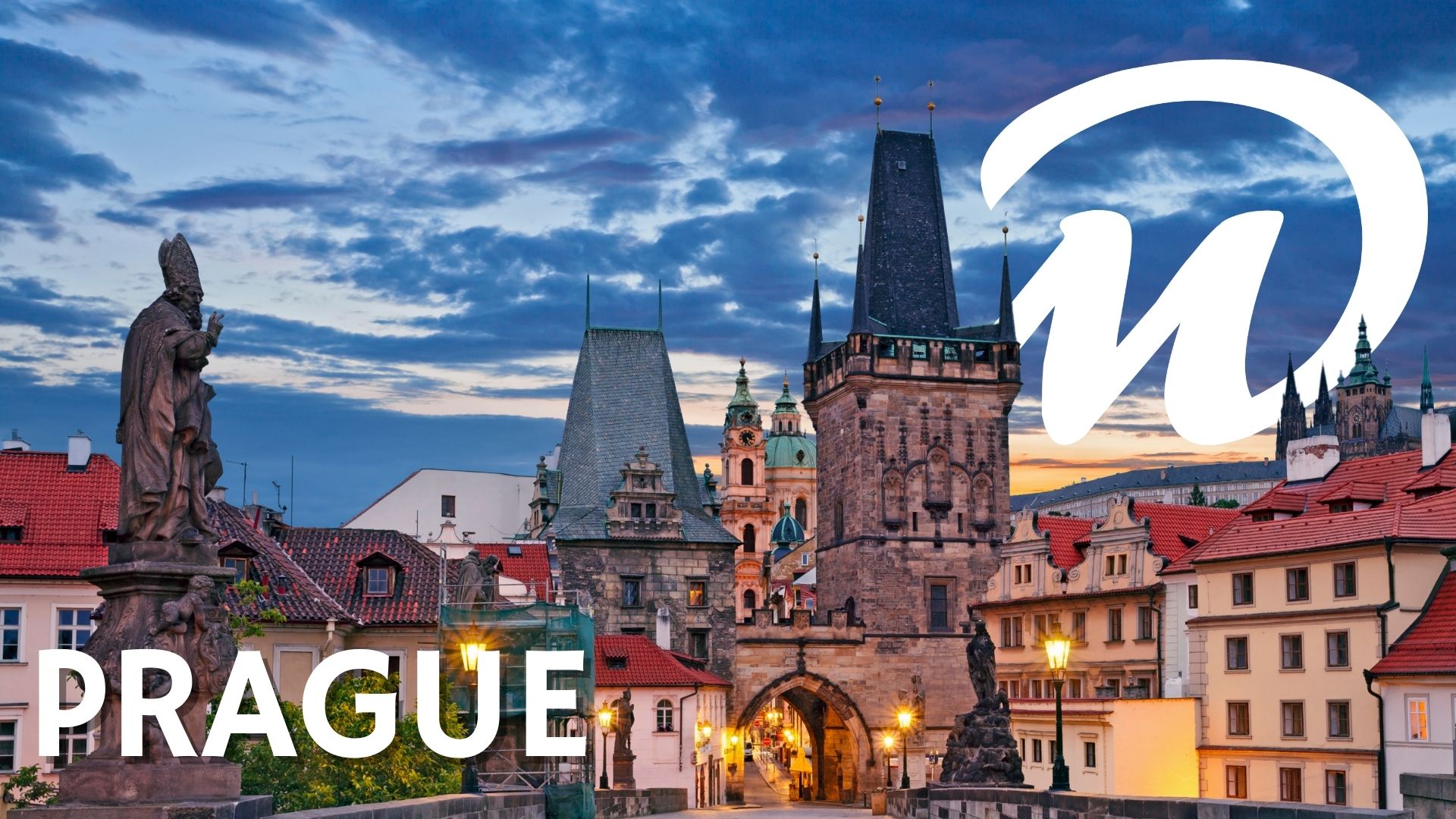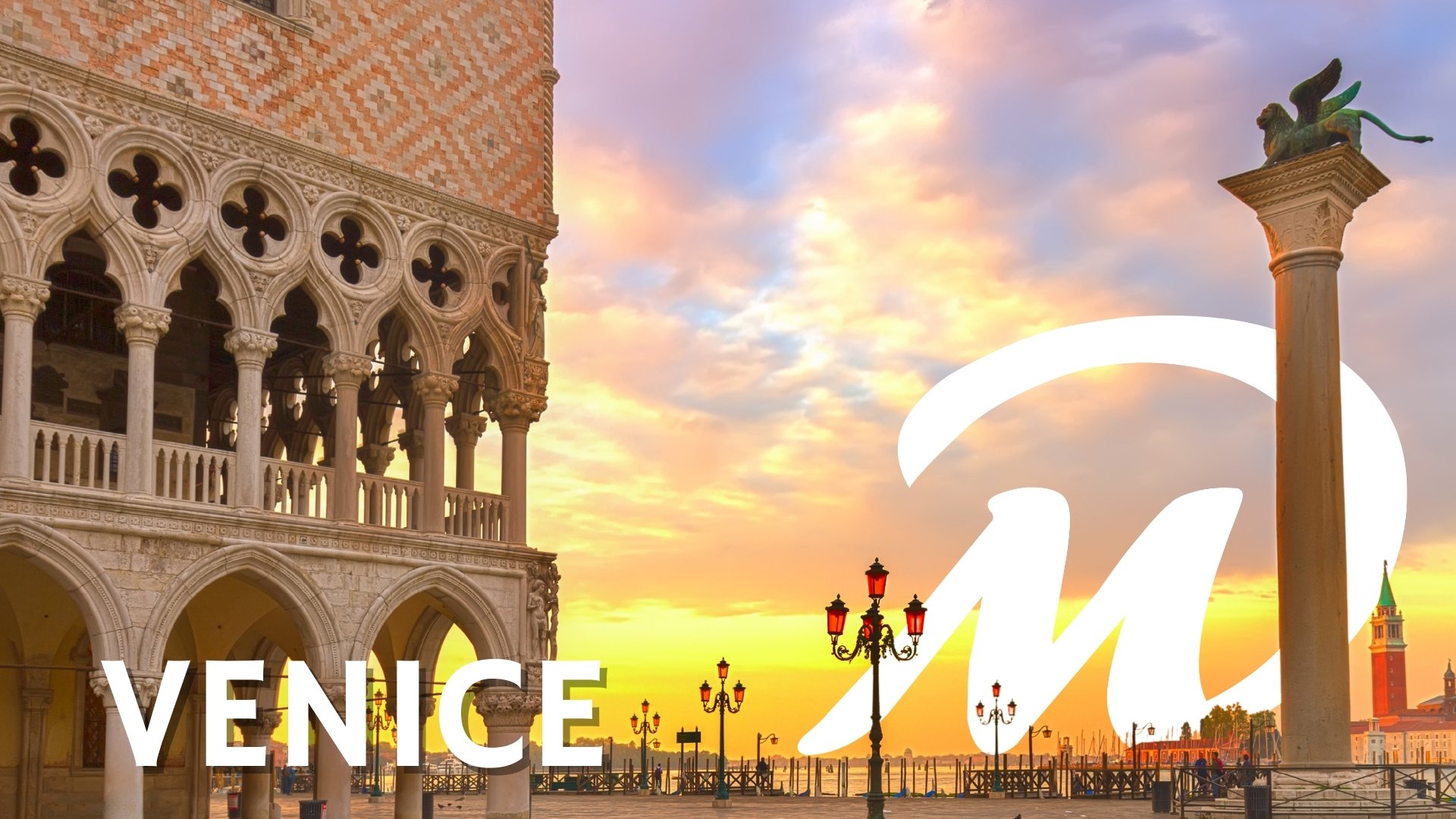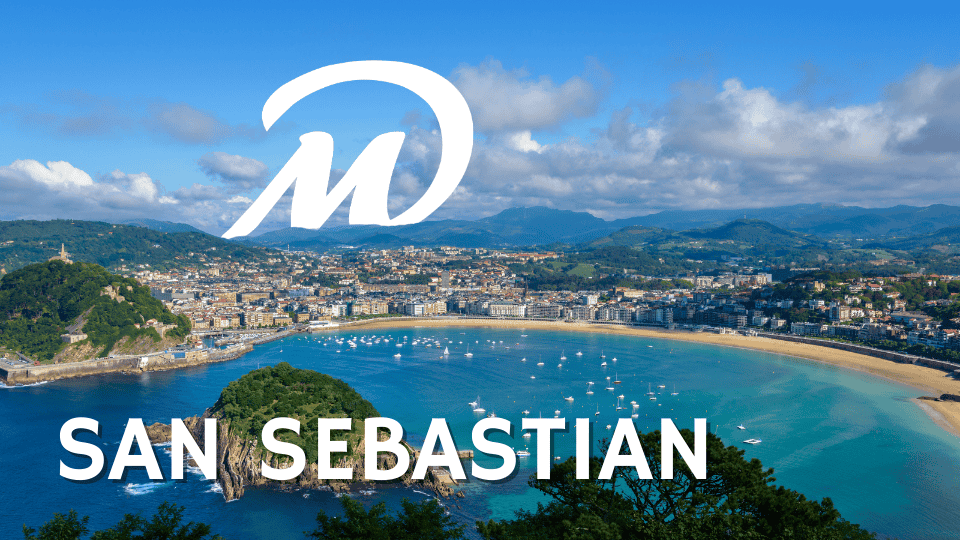If you’re looking for a city where past and present intertwine amidst market aromas, historic palaces and a sea of cultural influences, Palermo is your ideal destination. Capital of Sicily, this city has witnessed the passage of Phoenicians, Romans, Arabs, Normans and Spaniards, making it a melting pot of styles, flavours and traditions. Every corner of Palermo retains the imprint of a rich and complex history that is reflected in its architecture, its gastronomy and the passionate character of its people.
When you ask yourself things to do in Palermo, you will discover a fascinating city that never ceases to amaze. From the imposing Cathedral of Palermo, with its mix of Arab and Norman styles, to the Norman Palace, which hides one of the artistic jewels of Europe: the Palatine Chapel, decorated with dazzling Byzantine mosaics. Strolling through historic markets such as Ballarò or the Vucciria is an experience that mixes Mediterranean bustle with the most authentic essence of the city. Whether you wander through its narrow streets, visit its baroque churches or enjoy a granita by the sea, Palermo will enchant you with its authenticity and living history.
Do you want to keep searching through blogs, or do you prefer to have your guide of what to see in palermo ready?
The DareMapp app makes it easy. Enjoy the COMPLETE GUIDE ON YOUR MOBILE and experience every corner in a unique way. No timetables and at your own pace.
Things to do in Palermo: living history, intense flavours and a Mediterranean soul
Palermo is not only the capital of Sicily, it is a city that beats to the rhythm of its millenary history, its mixed culture and its vibrant spirit. From the Norman domes to the street markets that resemble an open-air theatre, this city grabs you from the first walk. In this blog, we will take you through the most emblematic places to see in Palermo, but also those hidden corners, secret courtyards and surprising churches that turn every walk into an adventure.
Palermo is a city with soul, and in this guide to things to do in Palermo you will discover how to explore it step by step, letting yourself be surprised by its history, its art… and its cuisine.
did you know that you can visit a marble-covered Baroque church, lose yourself among Byzantine mosaics, and end the day at a night market eating arancini for just a few euros? That’s Palermo: a powerful mix of contrasts, emotions and authenticity.
If you’re planning your trip and wondering things to do in Palermo, here’s a complete guide to the must-see sights… and much more.
Things to do in Palermo: keys to organise your visit
If you are looking for things to do in Palermo, get ready to immerse yourself in a city full of contrasts, intense flavours and a history that can be breathed in every corner. With Arab, Norman, Spanish and Baroque influences, Palermo is a cultural mosaic where past and present coexist with surprising naturalness. From gems such as the Norman Palace and Palermo Cathedral, to narrow streets with street art, hidden churches and lively popular markets, there is something for everyone.
Although it’s best to wander aimlessly and let yourself be carried away by the sights and sounds of the city, here’s a list of must-see places in Palermo to make the most of your trip.
Whether you’re a lover of history, urban photography, good food or spaces with character, Palermo has it all.
👁️Discover and explore things to do in Palermo, a city with more stories than excuses not to visit it.
Don’t miss them. With DareMapp, your new tourism app, guide on your mobile and without complications!
things to do in Palermo. TOP Points
Porta Nuova
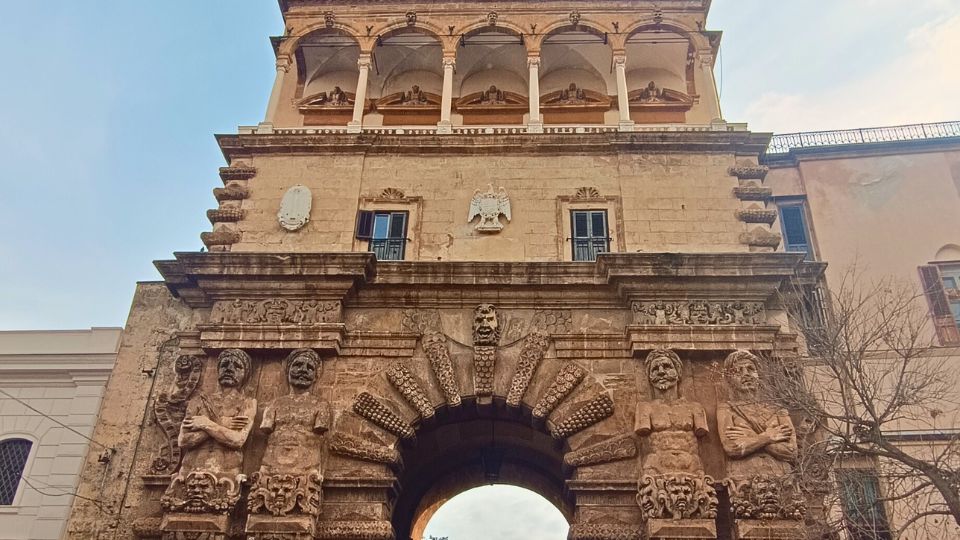
The Porta Nuova is one of the most imposing and significant monuments to see in Palermo, a gateway steeped in history that welcomes you to the heart of the city. It dates back to the 16th century, when it was erected to celebrate the triumphal entry of Emperor Charles V after his victory in Tunis. Although it was destroyed by fire, it was rebuilt in 1669 to its present appearance, and is notable for its monumental architecture and decorative sculptures symbolising power and conquest.
This monumental gate not only serves a symbolic function as the entrance to the historic centre, but also represents the passage between two worlds: the bustling contemporary Palermo and the ancient soul of the city.
Its design mixes Renaissance and Baroque elements, with reliefs depicting captive figures and decorations recalling imperial glory. It is not uncommon for travellers to stop and photograph its details before beginning to explore the treasures hidden within its walls.
Without a doubt, the Porta Nuova is a must-see in Palermo and an excellent starting point to immerse yourself in its history.
Norman Palace
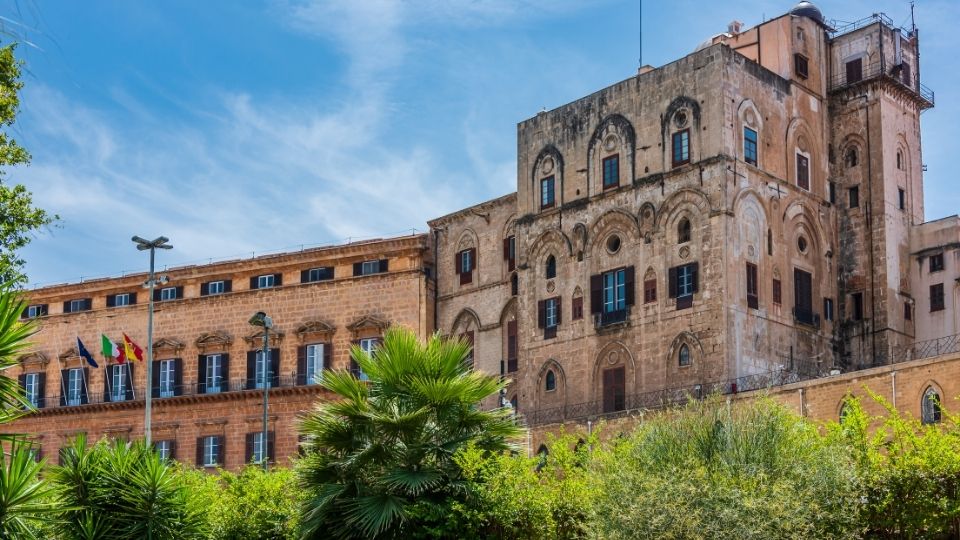
The Norman Palace is one of the most impressive historical buildings to see in Palermo and one of the oldest royal residences in Europe still in use. Its origin dates back to the 9th century, when the Arabs established their fortress here. However, it was the Normans who, after conquering the city in the 11th century, transformed it into a royal palace. For centuries, this building has been the centre of political power in Sicily, and even today it houses the seat of the Regional Assembly.
Its sober exterior contrasts with the dazzling interior, especially the Palatine Chapel, considered one of the jewels of medieval art. This chapel, integrated within the complex, is covered with gilded Byzantine mosaics that depict biblical scenes with a wealth of detail and colour that surprises all visitors.
In addition to the chapel, a tour of the palace reveals courtyards, decorated rooms and elements that show the fusion of cultures that have marked the history of Palermo: Arab, Norman, Byzantine and Baroque.
To visit the Norman Palace is to enter into the living history of Sicily and to discover one of the most emblematic places to see in Palermo, where every corner tells of centuries of power, art and cultural mix.
Massimo Theatre
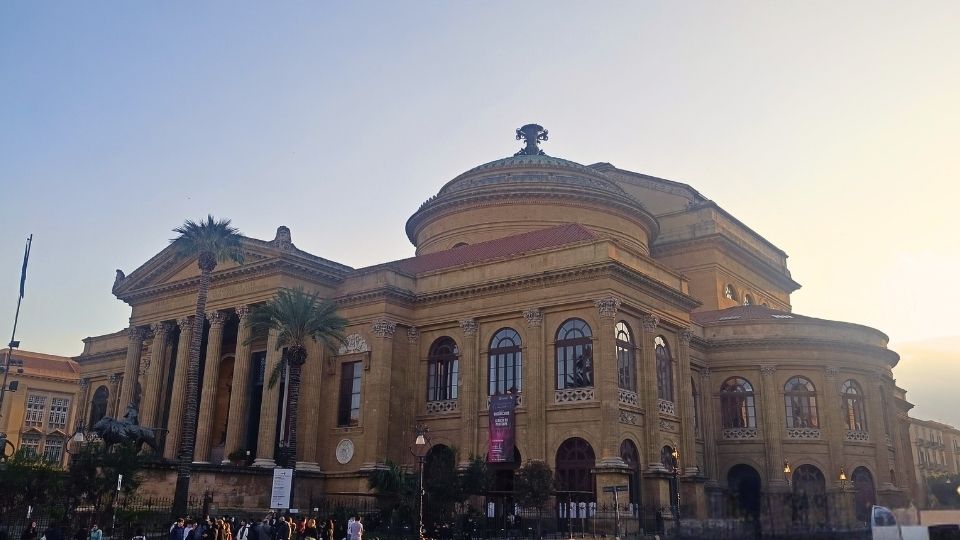
The Teatro Massimo is one of the most emblematic monuments to see in Palermo and a jewel of European theatre architecture. Inaugurated in 1897 after more than two decades of construction, this majestic building was designed by architect Giovan Battista Filippo Basile and completed by his son Ernesto. Its neoclassical style, inspired by Greek temples, is evident in the imposing façade with Corinthian columns and the great dome that crowns the building. The inscription “L’Arte rinnova i popoli e ne rivela la vita” (“Art renews the people and reveals their life”) presides over the entrance, recalling the deep connection between culture and identity.
Inside, the theatre dazzles with a horseshoe-shaped hall, decorated with red velvet, gilding and frescoes evoking the grandeur of Italian opera. With a capacity of over 1,300 spectators, it is renowned for its exceptional acoustics, considered among the best in the world. Throughout its history, the Teatro Massimo has been the stage for major productions and has hosted renowned international artists. Moreover, its fame transcended to the cinema when it appeared in the final scene of the film “The Godfather III”.
A visit to the Teatro Massimo is a must-see experience in Palermo, whether you attend a performance or take a guided tour to appreciate its architectural and artistic splendour.
Piazza San Domenico
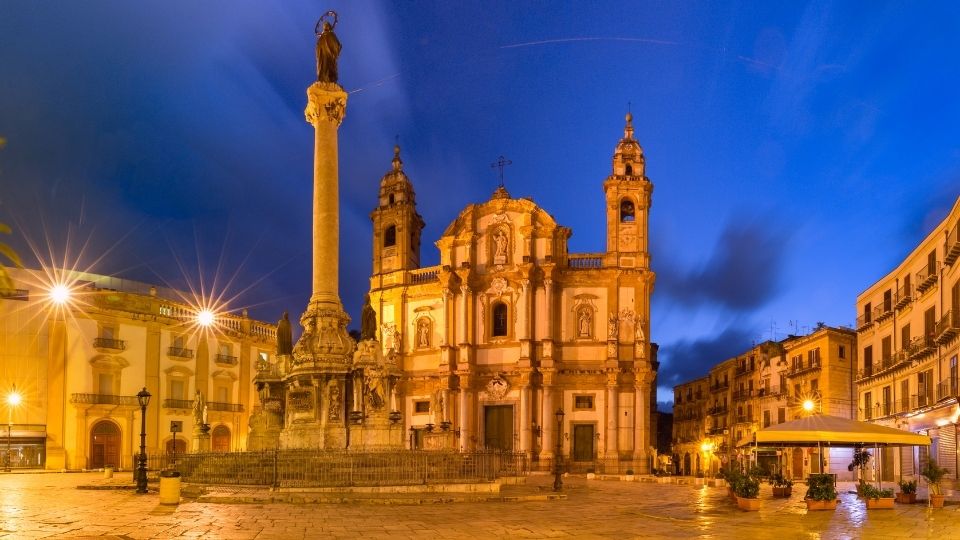
Piazza San Domenico is one of the most representative places to see in Palermo, located in the heart of the historic centre. Its current layout dates back to the 18th century, when it was redesigned to enhance the monumentality of the square and the church that presides over it. In the centre stands the Colonna dell’Immacolata, an elegant baroque marble column crowned by the figure of the Madonna, which has become one of the most important devotional symbols of the city.
The square is dominated by the church of San Domenico, also known as the “Pantheon of the illustrious Sicilians”, since important figures of Sicilian history rest in its interior. Its baroque façade and spacious, solemn interiors, decorated with sculptures, reflect centuries of architectural and artistic evolution. All around it, the atmosphere of Palermo can be felt in the cafés, flower shops and in the daily comings and goings of the locals.
For its history, aesthetics and cultural importance, Piazza San Domenico is a must-see in Palermo.
Pretoria Fountain
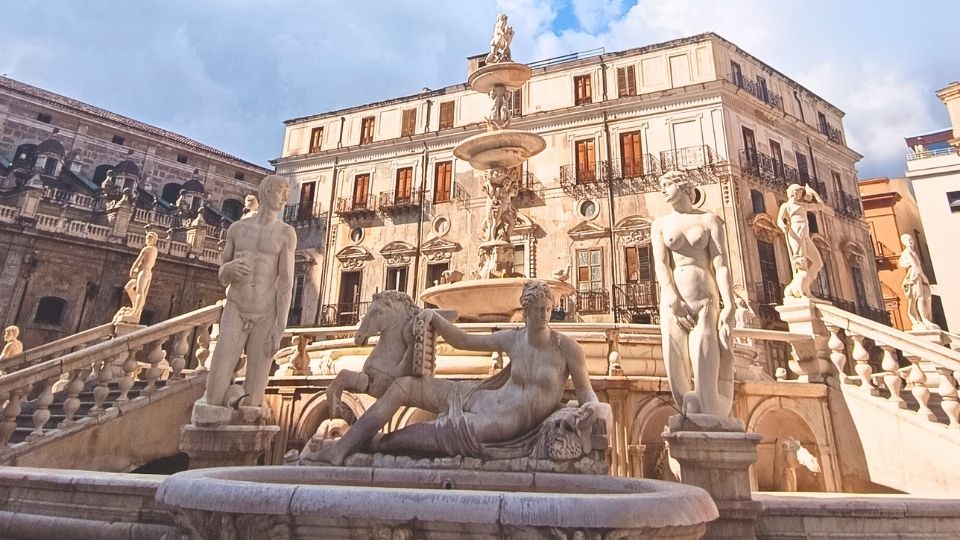
The Fontana Pretoria is one of the most impressive sculptural ensembles to see in Palermo, both for its Renaissance elegance and for the history that surrounds it. It was designed in 1554 by the Florentine sculptor Francesco Camilliani to adorn a private villa in Tuscany, but ended up in Palermo in 1573 after being acquired by the city’s Senate. The transfer was a real odyssey: more than 600 pieces of marble arrived by sea and were carefully assembled in the main square in front of the town hall.
This monumental fountain, installed in Piazza Pretoria, is remarkable for its mythological figures, fantastic animals and allegorical representations of rivers and classical divinities. The sculptures, many of them nude, scandalised the citizens of Palermo at the time, who ironically nicknamed it “the Fountain of Shame”. Despite initial criticism, it eventually became a symbol of the city and a true masterpiece of the late Renaissance in Sicily.
For its beauty, its scale and its location in the heart of the historic centre, the Fontana Pretoria is one of those must-see places in Palermo and a must-see for any visitor.
Palazzo Comitini
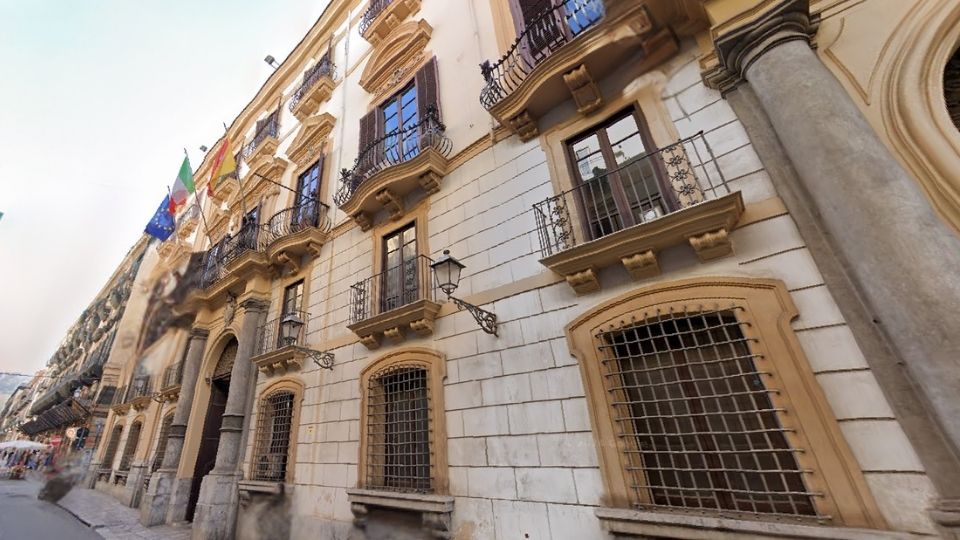
The Palazzo Comitini is one of the best examples of stately Baroque to see in Palermo, a city that does not skimp on historic palaces. Built in the 18th century by commission of Prince Michele Gravina Cruillas, this building was conceived as a luxury residence for one of the most influential families of the Sicilian nobility. Its sober façade, located in the middle of Via Maqueda, gives no hint of the artistic splendour that awaits inside.
Inside the palace, each room is a sample of the refinement of the period. The Sala Martorana stands out, decorated with allegorical frescoes and gilded details, as well as other rooms that preserve crystal chandeliers, tapestries and original furnishings. Although today it houses institutional offices, it is possible to visit some areas of the building by appointment or on special days, allowing you to enter a world of art and power that has endured for centuries.
If you are interested in architectural heritage and want to see another side of the city beyond the churches and fountains, Palazzo Comitini is definitely a must-see in Palermo.
Palazzo Bonocore

Palazzo Bonocore is a little-known but essential gem to see in Palermo, especially if you are interested in discovering the more refined and aristocratic side of the city. Located on a corner of Piazza Pretoria, this elegant 16th-century building has been home to noble families and the seat of municipal institutions, preserving a sober architecture on the outside, but with a surprisingly richly decorated interior.
After years of restoration, the palace has reopened as a cultural and exhibition centre combining technology and heritage. Inside you can visit rooms with frescoes, stuccoes and original furnishings, as well as interactive exhibits showing everyday life in 19th century bourgeois Palermo. The experience is not only aesthetic, but also narrative: touring the palace is like immersing yourself in an intimate history of the city.
If you are looking for a different and enriching plan, Palazzo Bonocore is definitely one of the most interesting stops to see in Palermo.
you can check the current exhibitions and buy your ticket online here.
We hope this guide to the must-sees in Palermo will help you discover the magic of the city. But if you want to live it to the fullest, don’t miss the DareMapp app!
With it you’ll have everything in just one app:
✅ Routes around the Cathedral, Villa Bonanno or Piazza Bellini, among other points.
✅ Local recommendations (the best cafés, breweries and the most important dishes).
✅ Excursions and fun activities in towns near the city.
nightlife plans (music bars, jazz clubs and more).
Everything to see in Warsaw and much more at your fingertips and from your mobile phone. Download it for free here!
💫You’re just one click away from swapping reading for adventure.
🗺️Your route through Palermo, with DareMapp
📍More than 30 points of interest
🚀An organised route to optimise your time
💡Recommendations, excursions & unique experiences
❓Questions, quizzes and more than 2h of narrated content
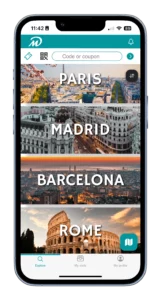
Remember that with DareMapp you can take a multitude of guided tours in an interactive way.
What better way than to travel and discover while learning in a fun way?


